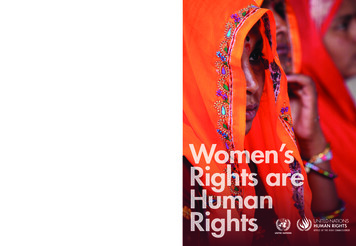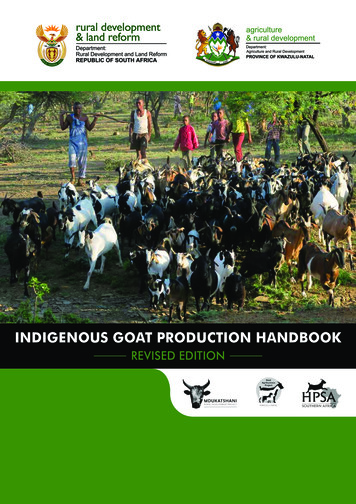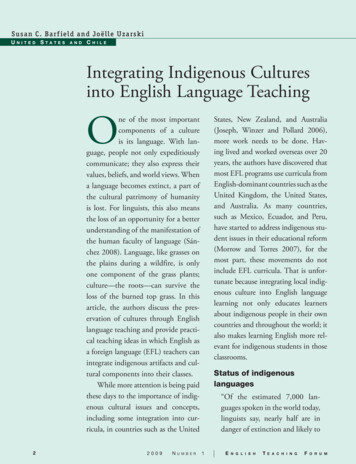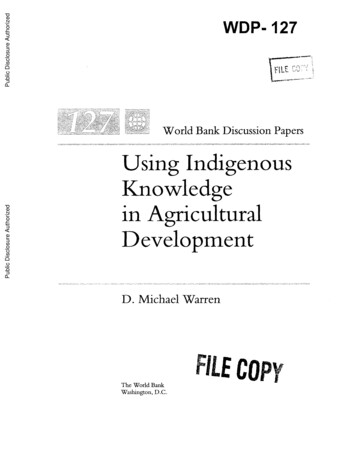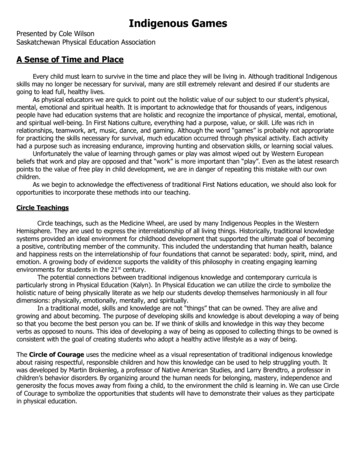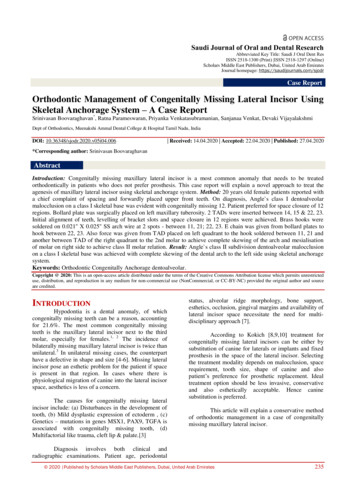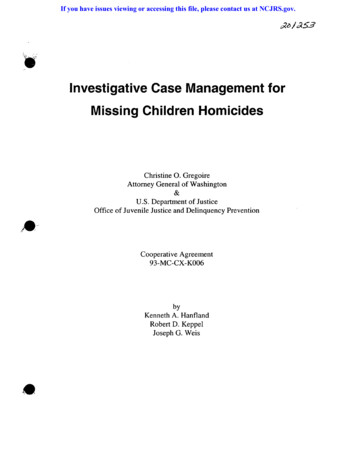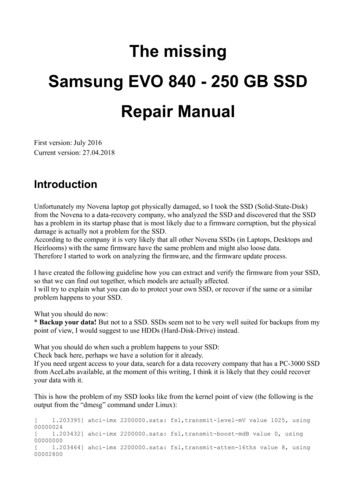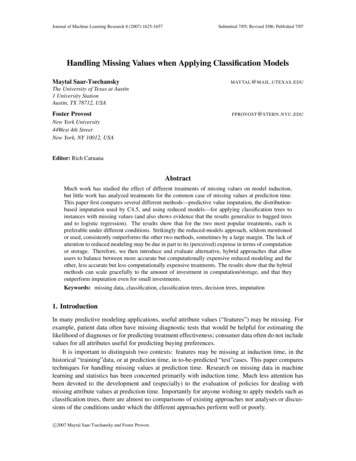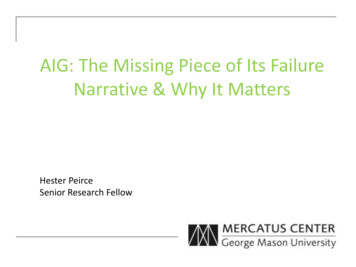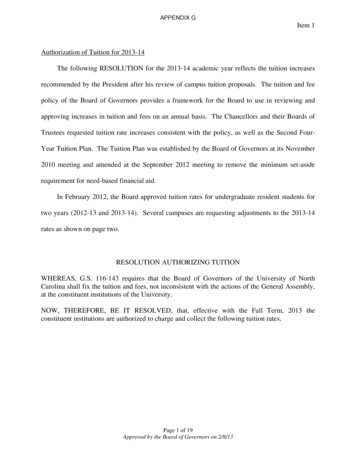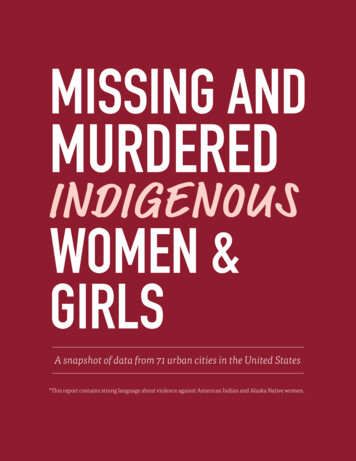
Transcription
MISSING ANDMURDEREDWOMEN &GIRLSA snapshot of data from 71 urban cities in the United States*This report contains strong language about violence against American Indian and Alaska Native women.Urban IndianHealth InstituteA Division of the Seattle Indian Health Board1
This report is the second of the Our Bodies, Our Stories series. Go to UIHI.org to read thefirst report regarding sexual violence against Native women in Seattle, Washington.Urban Indian Health Institute is a division of the Seattle Indian Health Board. Donateto future projects that will strengthen the health of Native people by going tohttp://www.sihb.org/get-involved-donate.
DUE TO URBAN INDIANHEALTH INSTITUTE’S LIMITEDRESOURCES AND THEPOOR DATA COLLECTION BYNUMEROUS CITIES,THE 506 CASES IDENTIFIEDIN THIS REPORT ARELIKELY AN UNDERCOUNT OFMISSING AND MURDEREDINDIGENOUS WOMEN &GIRLS IN URBAN AREAS.Urban IndianHealth InstituteA Division of the Seattle Indian Health Board1
A NATIONWIDE CRISIS:MISSING AND MURDEREDINDIGENOUS WOMEN & GIRLS5,712cases of MMIWGwere reportedin 2016Nationwide, the voices of Indigenous people have unitedto raise awareness of missing and murdered Indigenouswoman and girls (MMIWG). Though awareness of the crisisis growing, data on the realities of this violence is scarce.The National Crime Information Center reports that, in 2016, therewere 5,712 reports of missing American Indian and Alaska Nativewomen and girls, though the US Department of Justice’s federalmissing persons database, NamUs, only logged 116 cases.i,ii The Centerfor Disease Control and Prevention has reported that murder is theONLY 116of them were loggedin DOJ databasethird-leading cause of death among American Indian and AlaskaNative women and that rates of violence on reservations can be up toten times higher than the national average.iii, iv However, no researchhas been done on rates of such violence among American Indianand Alaska Native women living in urban areas despite the fact thatapproximately 71% of American Indian and Alaska Natives live in#3MURDERThe third-leading cause of deathamong American Indian/AlaskaNative women.iiiurban areas.vTo fill this gap, in 2017, Urban Indian Health Institute (UIHI), a tribalepidemiology center, began a study aimed at assessing the numberand dynamics of cases of missing and murdered American Indianand Alaska Native women and girls in cities across the United States.This study sought to assess why obtaining data on this violence is sodifficult, how law enforcement agencies are tracking and respondingto these cases, and how media is reporting on them. The study’sintention is to provide a comprehensive snapshot of the MMIWG crisisin urban American Indian and Alaska Native communities and theinstitutional practices that allow them to disappear not once, but threetimes—in life, in the media, and in the data.2MISSING AND MURDERED INDIGENOUS WOMEN & GIRLS
AN OVERVIEW OFMMIWG IN URBANAMERICADespite this ongoing crisis, there is a lack of data and aninaccurate understanding of MMIWG, creating a falseperception that the issue does not affect off-reservation/village American Indian and Alaska Native communities.71%of American Indians/Alaska Natives live inurban areas.vHowever, according to an analysis of 2016 Census data, 50.2%of the urban Indian population identified as female.vi The datain this report also includes LGBTQ, non-binary, and Two Spiritindividuals. The majority of American Indian and Alaska NativeUrban Indians are tribal peoplecurrently living off federallydefined tribal lands in urban areas.people now live in urban communities due to a variety of reasonsfor migration, from forced relocation due to 1950s federal relocationand termination policies, to current barriers to obtaining qualityeducational, employment, and housing opportunities on triballands. Because of this, urban American Indian and Alaska Nativepeople experience MMIWG-related violence in two ways—throughlosses experienced by extended family and community ties onreservations, in villages, and in urban communities themselves.Though there are critical issues regarding jurisdiction of MMIWGInstitutional racism is the process ofpurposely discriminating against certaingroups of people through the use of biasedlaws or practices. Often, institutional racismis subtle and manifests itself in seeminglyinnocuous ways, but its effects are anythingbut subtle.vii, viiicases on reservation and village lands, lack of prosecution, lackof proper data collection, prejudice, and institutional racism arefactors that also occur in urban areas.In this study, UIHI sought to demonstrate the ways in which theseissues also impact urban MMIWG cases, highlighting the results ofa deeply flawed institutional system rooted in colonial relationshipsthat marginalize and disenfranchise people of color and remainscomplicit in violence targeting American Indian and Alaska Nativewomen and girls.Urban IndianHealth InstituteA Division of the Seattle Indian Health Board3
COLLECTING THE DATAUIHI utilized a multi-pronged methodology to collect data on cases of MMIWG with theunderstanding that what is reported and recorded by law enforcement, covered by media, andremembered and honored by community members and family rarely matches.As demonstrated by the findings of this study, reasons for the lackof quality data include underreporting, racial misclassification,poor relationships between law enforcement and American Indianand Alaska Native communities, poor record-keeping protocols,institutional racism in the media, and a lack of substantiverelationships between journalists and American Indian and AlaskaNative communities.In an effort to collect as much case data as possible and to be ableto compare the five data sources used, UIHI collected data fromFreedom of Information Act (FOIA) requests to law enforcementRacial misclassification is the incorrectcoding of an individual’s race or ethnicity,e.g. an American Indian and Alaska Nativeindividual incorrectly coded as white.Misclassification generally favors the largerrace, so while American Indians and AlaskaNatives are often misclassified as white, thereverse of that is rare.ixThe Freedom of Information Act (FOIA)grants any person the right to requestaccess to federal agency records orinformation.xagencies, state and national missing persons databases, searches oflocal and regional news media online archives, public social mediaposts, and direct contact with family and community memberswho volunteered information on missing or murdered loved ones.UIHI’S DATA SOURCESLaw EnforcementRecords4State & NationalDatabasesMISSING AND MURDERED INDIGENOUS WOMEN & GIRLSMediaCoverageSocial MediaCommunity & FamilyMember Accounts
SeattleTacomaCITIES UIHI ATTEMPTEDTO COLLECT DATA FROMSpokaneMissoulaPortlandGreat FallsHelenaButteSanFranciscoDuluthSt. dSan JoseFargoRapid City PierreIdaho FallsEurekaReddingBismarckBillingsSalt Lake CityChicagoFarmingtonLos AngelesSan DiegoFlagstaffGallupPhoenixTempeWichitaSanta altimoreSt. LouisTulsaOklahomaCityDallasArlingtonSan colnFresnoSantaBarbaraGreen BayHoustonNew OrleansOrlandoAnchorageSitkaJuneauKetchikanUIHI attempted to collect data in71 cities across 29 states.In these FOIA requests, UIHI requested all case data from 1900to the present. No agency was able to provide data dating to 1900but providing such a large date range was useful in accessing asmuch data as the agency had readily available, which varied acrossDue to challenges in collecting data onhistorical cases, approximately 80% ofthe cases in this report have occurredsince 2000.jurisdictions. The oldest case UIHI identified happened in 1943, butapproximately two-thirds of the cases in UIHI’s data are from 2010to 2018. This suggests the actual number of urban MMIWG casesare much higher than what UIHI was able to identify in this study.These cities were selected because they either have an urban Indianhealth center that is affiliated with UIHI, a significant populationof urban Indians, or were found to have a large number of MMIWGcases in a preliminary consultation with key community leaders.Urban IndianHealth InstituteA Division of the Seattle Indian Health Board5
FINDINGSUIHI identified 506 uniquecases of missing and murderedAmerican Indian and AlaskaNative women and girls acrossthe 71 selected cities—128 (25%)were missing persons cases, 280(56%) were murder cases, and 98(19%) had an unknown status.A case was flagged as “status unknown” in two circumstances: whenlaw enforcement gave a number of total cases in response to a recordrequest but did not clarify how many were missing and how manywere murdered (16 cases total), and when a case was listed on a missingpersons database but had been removed, UIHI could not verify whetherthe woman or girl was located safe or deceased.The identified cases were widely distributed by age and tribal affiliation.The youngest victim was under one year old and the oldest was 83 yearsold. One hundred and thirty-five cases (27%) were victims aged 18 orunder, and mean victim age was approximately 29 years old (out of 387cases for which victim age was able to be determined).Approximately 75% of the casesUIHI identified had no tribalaffiliation listed.UIHI identified 96 cases that were tied to broader issues such asdomestic violence, sexual assault, police brutality, and lack of safety forsex workers. In this report, domestic violence includes intimate partnerviolence and family violence. Forty-two (8% of all cases) cases weredomestic violence related, and 14% of domestic violence fatalities wereSixty-six out of 506 MMIWG casesthat UIHI identified were tied todomestic and sexual violence.victims aged 18 and under. Three victims were pregnant at their timeof death. At least 25 victims (6% of all cases) experienced sexual assaultat the time of disappearance or death, 18 victims (4% of all cases) wereidentified as sex workers or victims of trafficking, and 39% of victimsin the sex trade were sexually assaulted at the time of death. For thisreport, sexual assault is defined as penetrative and non-penetrativeThe youngest victim was a baby lessthan one year old.sexual violence and includes victims who were found murdered and leftnude. Eight victims were identified as homeless, six were trans-women,and seven were victims of police brutality or death in custody.The oldest victim was an elderwho was 83 years old.UIHI was able to identify the victim’s relationship to the perpetrator in24 cases; of these, 13 victims were killed by a partner or the partner of animmediate family member, three were killed by an immediate familymember, six were killed by a serial killer, and two were killed by a drugdealer. Of the perpetrators UIHI was able to identify, 83% were male andapproximately half were non-Native. Thirty-eight of the perpetratorswere convicted, while nine were never charged, four were acquitted, onehad a mistrial, and one committed suicide. Altogether, 28% of theseperpetrators were never found guilty or held accountable. Anadditional 30 alleged perpetrators have pending charges.6MISSING AND MURDERED INDIGENOUS WOMEN & GIRLS
MMIWG STATISTICS FROM A SURVEYOF 71 CITIES ACROSS THE U.S.The ribbon skirt is a form of cultural clothingthat represents the sacredness of AmericanIndian and Alaska Native women and thedeep connection their bodies and spirits haveto the land. Just like a skirt, each AmericanIndian and Alaska Native community hasits own beauty and stories of resiliencedespite multiple ribbons of trauma andviolence stacked upon them. We chose torepresent the study’s findings in this way tohonor the sacredness of our urban missingand murdered Indigenous women andgirls, the prayers we hold them in, and theresponsibility we have to care for their stories.Urban IndianHealth InstituteA Division of the Seattle Indian Health Board7
THE INVISIBLE 153Number of casesidentified by UIHI thatcurrently do not existin law enforcementrecords.
GEOGRAPHYThe 506 cases UIHI identified were dispersed over a wide geographic area. Regionally, theSouthwest (157), Northern Plains (101), Pacific Northwest (84), Alaska (52), and California (40)were the areas with the highest number of cases. The cities that figure most prominently in thedata are Seattle (45), Albuquerque (37), Anchorage (31), Tucson (31), and Billings (29).AREAS WITH THE HIGHEST NUMBER OF CASES (BY REGION)SouthwestNorthern PlainsPacific NorthwestCaliforniaThe states with the highest number of cases arewhile the records provided by San Francisco policeas follows: New Mexico (78), Washington (71),did not specify the name or status of any victim.Arizona (54), Alaska (52), Montana (41), CaliforniaOmaha figured prominently in this list because,(40), Nebraska (33), Utah (24), Minnesota (20), andlike many jurisdictions across the country, whenOklahoma (18).a person listed on the Nebraska missing personsThe areas with the largest number of urban caseswith an unknown status were Albuquerque (18), SanFrancisco (16), Omaha (10), and Billings (8). Notably,both Albuquerque and Billings police departmentsacknowledged FOIA requests but did not provide anyrecords or information or respond to any follow-up,10AlaskaMISSING AND MURDERED INDIGENOUS WOMEN & GIRLSdatabase is located, the notice is removed with nopublic information as to whether they were foundsafe or deceased. Together, these cities highlight theneed for changes to public information systems onmissing persons and improvement in cooperationfrom law enforcement agencies.
TOP 10 CITIES WITH HIGHEST NUMBER OF MMIWG CASESSeattle, WA (45)Albuquerque, NM (37)Anchorage, AK (31)Tucson, AZ (31)Billings, MT (29)Gallup, NM (25)Tacoma, WA (25)Omaha, NE (24)Salt Lake City, UT (24)San Francisco, CA (17)See Appendix for data from all 71 cities surveyed.TOP 10 STATES WITH HIGHEST NUMBER OF MMIWG CASESNew Mexico (78)Washington (71)Arizona (54)Alaska (52)Montana (41)California (40)Nebraska (33)Utah (24)Minnesota (20)Oklahoma (18)Urban IndianHealth InstituteA Division of the Seattle Indian Health Board11
CHALLENGES ANDOBSTACLES IN OBTAININGMMIWG DATA“Until there is cooperation andbetter tracking systems at allgovernment levels, the data onmissing and murdered Indigenouswomen will never be 100 percentaccurate, which is what we needto strive for in order to protect ourmothers, daughters, sisters, andaunties.”- Abigail Echo-Hawk (Pawnee), Director,Urban Indian Health InstituteACCESSING LAW ENFORCEMENT DATAUIHI filed FOIA requests with municipal police departments inall 71 cities included in the survey. In the case of Alaska, UIHI alsofiled a request with the Alaska Department of Public Safety (DPS)because a case that occurred in a major city was not consideredcity jurisdiction. To ensure other such cases would be included inthe data, a request to DPS was necessary.Initially, these requests were filed via the agency’s online requestsystem, when one existed, and, in cases where there was no suchsystem, via email. Where no online system or email was available,no contact was made. After a significant portion of these initialrequests never received a response, UIHI utilized MuckRock, apaid service that assists in FOIA requests, to re-file prior requestsand file new requests with agencies that had no online system oremail available.In these requests, UIHI asked for all data on cases of missingpersons (unsolved only), homicides, suspicious deaths, and deathsin custody (solved and unsolved) involving an American Indianor Alaska Native victim that was female or identified as a transwoman/girl.12MISSING AND MURDERED INDIGENOUS WOMEN & GIRLS
FOIA RESULTSSeventy-one city police agencies and one statepolice agency were surveyed. Forty agencies(56%) provided some level of data. Thirty-threeof the 40 (and 46% of all surveyed) actuallysearched their records, though not all providedcomprehensive data. Ten out of the 40 agenciesprovided data but with a “caveat”, meaning they71 CITY POLICEDEPARTMENTS AND1 STATE AGENCYWERE SURVEYED.only confirmed cases UIHI had already logged,provided what they could recall from memory,or gave partial data. Fourteen of the 72 agenciesOUT OF THOSE:surveyed (20%) did not provide data, and 18(25%) are still pending. Those combined withthe 10 “caveat” cases comprised 59% of all theagencies surveyed. In sum, nearly two-thirdsof all agencies surveyed either did not providedata or provided partial data with significantcompromises.40 AGENCIESPROVIDED SOMELEVEL OF DATAThirteen of the 72 agencies surveyed (18%) didnot respond to our FOIA request within the timelimit set by local statute, and an additional 12agencies (17% of all agencies) failed to respondwithin their local time limit by ignoring thefirst attempt, but did respond in time whena second request was filed nine months laterusing MuckRock. Combined, these 25 agencies“It is unacceptable that law enforcement feelrecalling data from memory is an adequateresponse to a records request. In the oneinstance where this occurred and theofficer searched their records after, severaladditional cases the officer could not recallwere found. This highlights the need forimproved records provision standards andshows that the institutional memory of lawenforcement is not a reliable or accuratedata source.”- Annita Lucchesi (Southern Cheyenne), PhD-c14 AGENCIESDID NOTPROVIDE DATA18 AGENCIESSTILL HAVEPENDING FOIAREQUESTSas of our cutoff date,October 15, 2018Urban IndianHealth InstituteA Division of the Seattle Indian Health Board13
represent over one-third (35%) of all agencies surveyed. Sixagencies never responded to any FOIA requests: Albuquerque,Baltimore, Butte, Reno, San Jose, and Tempe. Sixty agencies(83%) required more than one communication regarding UIHI’srequest. Of those 60, 29 (40% of all agencies) needed more thantwo, and 16 (22% of all agencies) needed more than five.The findings highlight that the FOIA process is, at best,laborious, requiring intensive follow up and resources from theDepartments like Anchorageand Lincoln demonstrate thatit is possible for urban policedepartments to respond toFOIA requests for such data andthat the barriers other agencieshave identified are not inherentto law enforcement as a whole.requesting agency. For example, a representative from JuneauPolice in Alaska explained that they received UIHI’s initialrequest at the same time as an unaffiliated project at anotherinstitution filed a request for data on sexual assault on AlaskaNative women. The agency assumed any request on violenceagainst Alaska Native women must have come from the samesource, so, when they filled the other institution’s request, theyclosed out UIHI’s. Similarly, in an October 2018 phone call,a representative from the Los Angeles Police claimed UIHI’stwo prior FOIA requests to their agency had been closed outby being lost in the system due to understaffing. They had a“Your assertion that we have ignoreda similar request from eight monthsago is false. Unless you sent yourrequest elsewhere, this is the firsttime we have seen it.”-Chief of Police in Billings, Montana, afterreceiving a second FOIA request. Afterreceiving screen shots of first request, nofurther response was given.backlog of thousands of requests that three staff memberswere responsible for filling, and many were not answered (asUIHI’s first request was) or were rerouted to the wrong agency(as UIHI’s second request was). An entire year later, the agencyexpected UIHI to file a third request and “get back in line.”In another case, the Chief of Police in Billings, Montana, afterhaving received a second FOIA request from UIHI, wrote, “Yourassertion that we have ignored a similar request from eightmonths ago is false. Unless you sent your request elsewhere,this is the first time we have seen it.” UIHI responded withscreenshots of the initial request and of the automatic emailreceived stating that the request was received and wasprocessing, but UIHI never received any response to the emailor to the record request to date.However, some agencies were helpful and provided casedata in a timely manner. For example, a representativefrom the Anchorage police department was one of the veryfirst to provide comprehensive data on MMIWG cases intheir jurisdiction. Not only did they search their records for14MISSING AND MURDERED INDIGENOUS WOMEN & GIRLS
cases, they also searched the name of each case UIHI had loggedto determine why they may not appear on the department’ssearch results. Similarly, a representative from the Lincoln policedepartment called for clarification of the request to ensure that theywere pulling all of the pertinent records. They were very supportiveof the project and dedicated hours of research at no cost to providecase data dating back to 1962.FEES FOR ACCESSING DATAThirteen percent of all agencies surveyed charged a fee foraccessing data: Fairbanks, Flagstaff, Juneau, Sitka, Kansas City,Ketchikan, Portland, Salt Lake City, Tucson, and Utqiagvik.If UIHI had paid every invoice received, it would have cost 4,464.48 (not including the cost of the paid service for the 4,464Total Required Fees(from 13% of the cities) 68UIHI’s Budgetfor FOIA FeesFOIA requests). Alaska agencies comprised 93% of the totalcosts of invoices. The invoices UIHI paid totaled 68, and,in turn, UIHI received data from three cities, resulting in anadditional 51 cases logged. Portland police never provided anydata despite their invoice being paid. As a small AmericanIndian and Alaska Native organization with limited resources,UIHI was unable to pay a majority of the fees and thus wasunable to access the data.Of the agencies that did provide some kind of data, nine (23%)located data prior to 1990, 18 (45%) located data prior to 2000,and 29 (73%) located data prior to 2010. Accessing historicaldata was extremely difficult.FOIA REQUEST TO ALASKAAfter UIHI’s FOIA request was rejected by the Alaska StateTroopers for being too burdensome, an appeal was deniedby the Department of Public Safety because they estimatedthere were between 800 and 1,200 homicides of AlaskaNative women since 1940 and it would require too manywork hours to complete the request. Using one of thefrom a prominent Alaska Native triballeader, after which the agency offeredto provide data only from 2013 to 2018because those records had been digitizedand were searchable. However, UIHI hasstill not received the data to date.author’s connections in Alaska, UIHI received assistanceUrban IndianHealth InstituteA Division of the Seattle Indian Health Board15
“[Many] Native Americans adoptedHispanic names back duringcolonial times Our crime systemsare not flexible enough to pickout Native Americans fromothers in the system it wouldbe impossible to compile anystatistically relevant informationfor you.”-Representative from Santa Fe PoliceDepartmentLACKING RECORDS AND RACIAL MISCLASSIFICATIONNine cities (13% of total) reported the inability to search forAmerican Indian, Native American, or Alaska Native in their datareporting systems despite the common and expected practiceof classifying victims by race in data systems. A representativefrom Santa Fe police wrote, “[Many] Native Americans adoptedHispanic names back during colonial times Our crime systemsare not flexible enough to pick out Native Americans from othersin the system it would be impossible to compile any statisticallyrelevant information for you.”In Seattle, UIHI was initially provided one list then subsequently“[Regarding the difference] theHomicide unit found that ‘N’ wasbeing used in the 60s up throughthe late 70s and early 80s – meantNegro not Native American.”-Representative from Seattle PoliceDepartmentprovided another. Considering they had significant overlap, UIHIasked for an explanation of the difference between the two andwere told: “[Regarding the difference] the Homicide unit foundthat ‘N’ was being used in the 60s up through the late 70s andearly 80s – meant Negro not Native American.” However, all ofthe names that were on the original list—which presumably hadboth American Indian and Alaska Native and African Americannames on it—were also on the second list and did not provideany clarification.“Sometimes the information [ona victim’s race] would not beasked and our record systemdefaults to white.”-Representative from Fargo PoliceDepartmentAdditionally, several police departments provided UIHI with datathat included both American Indians and Indian-Americanswith visibly Indian-American surnames (e.g. Singh). When askedabout this misclassification, a representative from Sacramentopolice claimed the Indian-American names must be victims whowere biracial.Misclassification can also occur due to lack of recognition oftribal nations. UIHI found that if a woman or girl was killedduring the time their tribe was terminated, her citizenship mayhave never been restored when her nation was re-recognized,and she may have been falsely classified as white—or not raciallyclassified at all—in documentation regarding her case. Thesecases would not be included in search results constrained tosearching for records of Native American females. This is anissue that still impacts contemporary cases involving victimsfrom tribes that are not federally recognized, and lack ofrecognition is an issue that disproportionately affects urban16MISSING AND MURDERED INDIGENOUS WOMEN & GIRLS
Indian communities. For example, Seattle, Sanas an overdose when her body had been movedFrancisco, and Los Angeles each are located onand disposed of suspiciously, and one was nothomelands belonging to tribes that are not federallyconsidered as having happened within the cityrecognized (the Duwamish, Ohlone, and Tongvabecause she had been kidnapped from a bar withinpeoples, respectively). In this way, it is possible thatthe city but killed just outside of it.American Indian and Alaska Native women and girlsindigenous to the land the city is located on maynot even be included in the city’s data on AmericanIndian and Alaska Native people, and their deathsand disappearances go uncounted on their ownThrough research methods outside of FOIArequests (government missing persons databases,news reports, social media and advocacy sites,direct contact with families and communityhomeland.members who volunteered info), UIHI found 153UIHI found that it was not just racial categoriesall of the data gathered in the 40 cities where FOIAthat held misclassifications. Records obtainedrequests produced results, 42% of the cases werefrom Anchorage police showed that two-thirds offound by UIHI’s diligent research and not presentthe cases UIHI identified that were not in the datain law enforcement data. This 42% was made upthe agency provided were, indeed, in their system,of cases from 26 of the 40 cities (65%). The citiesbut three cases were misclassified as white, onewhere UIHI located the highest number of cases notwas classified as a suicide (despite the case havingfound in law enforcement records are listed in thebeen reopened as a homicide), one was classifiedtable below.cases that were not in law enforcement records. OfTOP 10 CITIES WITH HIGHEST NUMBER OF MMIWG CASES THAT ARE NOT IN LAW ENFORCEMENT RECORDSCITYNUMBER OF CASESCITYNUMBER OF CASESGallup, NM20Farmington, NM9Billings, MT17Denver, CO7Omaha, NE16Oklahoma City, OK7Seattle, WA11Rapid City, SD6Anchorage, AK9Great Falls, MT5Urban IndianHealth InstituteA Division of the Seattle Indian Health Board17
URBAN MMIWGIN THE MEDIAMETHODSUIHI conducted a content analysis of mediacoverage on MMIWG in the areas covered by thestudy. The vast majority of coverage on MMIWG,both on individual cases and on the issue overall,was centered on reservation-based violence.MORE THAN 95%of the cases in this study werenever covered by national orinternational media.Though coverage of reservation-based violenceis critical, this bias does work to collectivelyminimize this issue in urban spaces. It also bolstersstereotypes of American Indian and Alaska Nativepeople as solely living on reservations or in ruralMedia Coverageareas, perpetuates perceptions of tribal lands asUIHI examined 934 articles, which collectivelyviolence-ridden environments, and, ultimately,covered 129 cases out of the 506 represented in theis representative of an institutional bias of mediastudy. One-quarter of the total number of cases werecoverage on this issue. Additionally, media sourcescovered by local, regional, or national media. Lesshave used language that could be perceived asthan one-fifth of the total number of cases wereviolent and victim-blaming in their coverage ofcovered more than once (14%), less than one-tenthMMIWG cases. This type of coverage can alsowere covered more than three times (7%), and lessperpetuate negative stereotypes of Americanthan 5% of cases were covered more than five times.Indian and Alaska Native women and girls, so UIHIThe top ten cases that received the most coveragealso conducted a qualitative analysis to identifycomprised 62% of all coverage, and 47% of coveragethis type of language.was regarding just one case. Nearly all of the articlesUIHI conducted a comprehensive online search formedia coverage on all 506 cases represented in thedata. Each publicly-available article UIHI found waslogged, assessed and coded for the type of languageit used, and attributed to the outlet that originallypublished it.18FINDINGSMISSING AND MURDERED INDIGENOUS WOMEN & GIRLSUIHI surveyed (91%) regarded a murder case, and83% of the cases covered by media were murdercases. There were 27 articles printed in national orinternational media, covering 21 cases.
Violent LanguageFor the purposes of this analysis, UIHI definedTYPES OF VIOLENT LANGUAGEUSED IN ARTICLESviolent language as language that engagesin racism or misogyny or racial stereoty
Oct 15, 2018 · approximately 71% of American Indian and Alaska Natives live in urban areas.v To !ll this gap, in 2017, Urban Indian Health Institute (UIHI), a tribal epidemiology center, began a study aimed at assessing the number and dynamics of cases of missing and murdered American Indian and Alaska N

